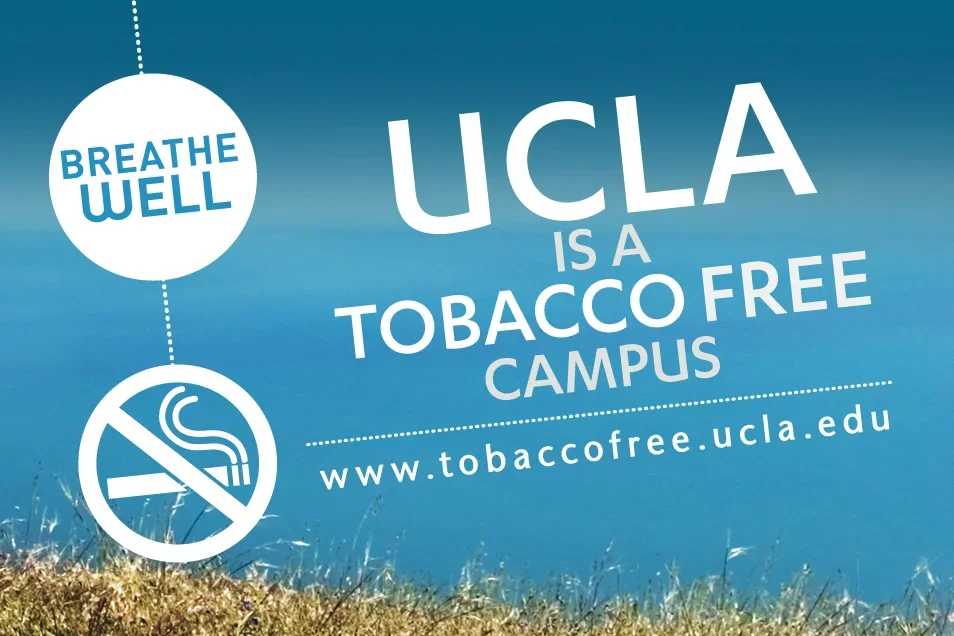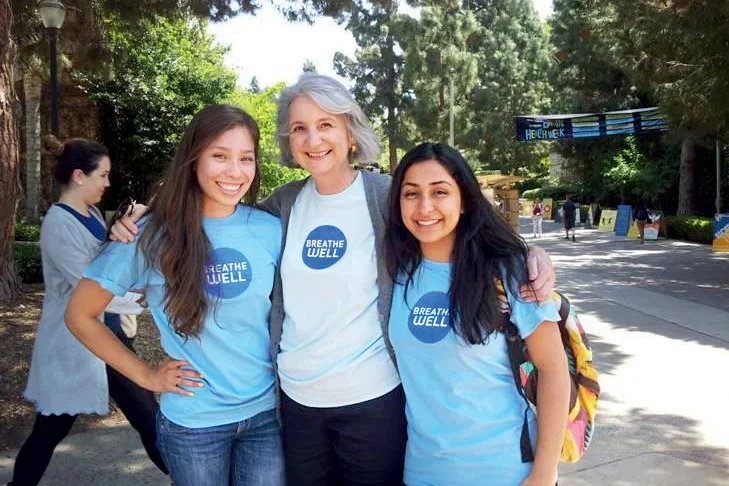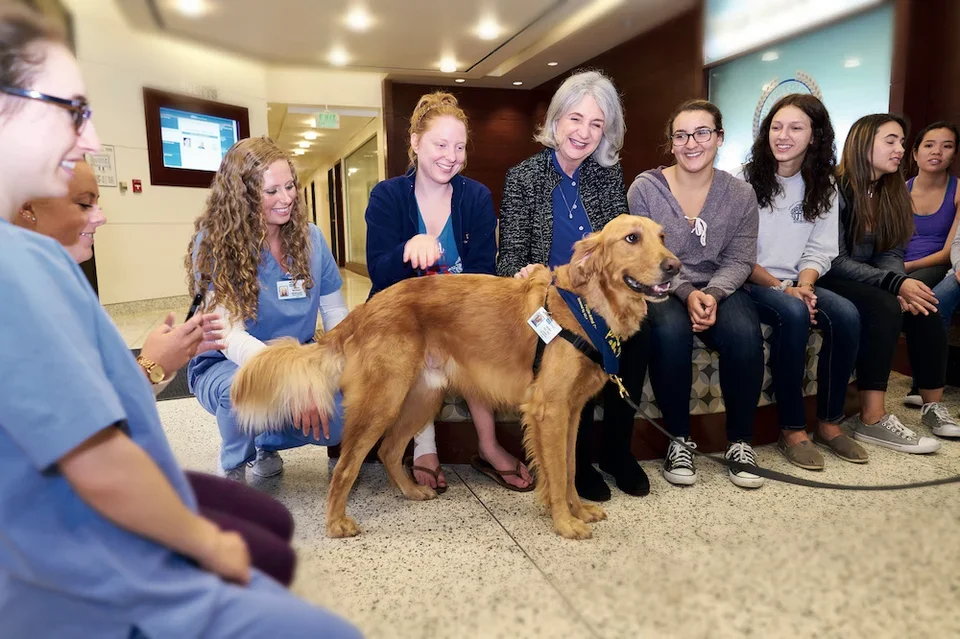Embracing New Ways to Live Well

Not long after Angelina Cordova started her studies at UCLA’s School of Nursing, she and a friend formed a fitness group aimed mainly at avoiding excess pounds. “We’d heard about the increased obesity rates among nurses and we wanted to take care of ourselves,” said Cordova, who graduated in June. “but we soon realized the problem was so much bigger, with issues of stress, lack of sleep, risk of burnout and leaving the profession,” Cordova said. “We realized we needed to broaden the scope.”
Thus began Wellness in Nursing, a student-run organization that puts on fitness and stress-busting events and focuses on the importance of self-care among health professionals.
The group’s activities dovetail with efforts by the UCLA School of Nursing and leaders at the UCLA Health system to help professionals improve their own wellbeing and in turn deliver the best possible care to their patients. These efforts include cutting-edge research on ways to build resiliency and avoid burnout, projects to build teamwork among members of the medical staff, weekend retreats and a hospital staff meditation room to give overtaxed professionals ways to recharge.
CREATING A HEALTHY CAMPUS
It’s all happening against the backdrop of UCLA’s Healthy Campus Initiative (HCI), an ambitious, cutting edge campaign to create an environment of health and make the Westwood campus a leader in promoting the physical and emotional wellbeing of students, faculty and staff. Its framework rests on five “pods”—Breathe Well (which helped implement UCLA’s ban on tobacco use), Eat Well, Move Well, Mind Well and Be Well. It seeks to find ways to promote healthy living at UCLA. The idea is to immerse the campus in opportunities--and reminders—to make wellbeing a priority.
Oversize posters on parking garage elevator doors remind users that a free workout—the stairs—is just steps away. Signs serve as reminders that “UCLA is a tobacco free campus.” Vending machines and dining halls have added healthier options to their wares. Music beckons staff and students to take a break from their hectic schedules and therapy dogs have been brought to Powell Library—and, recently, the School of Nursing—to provide a little stress relief during final exams.

The Healthy Campus Initiative is envisioned and supported by Jane and Terry Semel. Terry said: “Let’s do it well in one place—and why not here at UCLA—prove that it works and the rest will follow.”
Others are following. In 2014, Partnership for a Healthier America, which worked with Michelle Obama to improve the nation’s eating and other health habits, announced it was creating a Healthier Campus Initiative, based on UCLA’s model.

EARLIER THIS YEAR, SARNA AND COLLABORATOR STELLA AGUINAGA BIALOUS OF THE UNIVERSITY OF SAN FRANCISCO’S SCHOOL OF NURSING WERE DESIGNATED “EDGE RUNNERS” BY THE AMERICAN ACADEMY OF NURSING. THE HONOR CAME FOR THEIR TOBACCO FREE NURSES MODEL, AIMED AT REDUCING TOBACCO USE AMONG NURSES AND NURSING STUDENTS AND INCREASING NURSING’S INVOLVEMENT IN TOBACCO CONTROL.

Wendelin M. Slusser, MD, Associate Vice Provost of the HCI, heads UCLA’s initiative. She noted that UC President Janet Napolitano’s interest has led to an 18-month pilot program, dubbed the Healthy Campus Network, to try out the UCLA model throughout the University of California system.
“We still have a lot of work to do but the stars are aligned,” Slusser said. “It’s all about engaging and connecting the talented and committed students, staff and faculty on the UCLA campus.”
School of Nursing Dean Linda Sarna said the initiative “is about helping the UCLA campus community and beyond make informed choices about their health.
“Whether it’s about nutrition, physical activity, tobacco use or mental health, the goal is to leverage our unique strengths as a leading research university to encourage healthier outcomes for individuals and for society as a whole.”
Sarna said the initiative creates an environment for participation and fosters further innovations by the nursing school and other health-related departments and services.
Slusser credits Sarna’s leadership for UCLA becoming one of the first large universities in the nation to implement a tobacco-free policy. All tobacco use—including vaping—is forbidden anywhere on campus. “Linda has been at ground zero for all of this work,” Slusser said, noting Sarna’s work predated the Healthy Campus Initiative, which embraced it in one of its first steps.
UCLA HEALTH – CREATING IT’S OWN CULTURE OF WELLBEING
While the Healthy Campus Initiative seeks to make UCLA “the healthiest campus in America,” efforts are underway at UCLA Health to ensure the wellbeing of its health care professionals—and in turn light the way for doctors and nurses around the nation.

Noting that the American Nurses Association has declared 2017 as the “year of the healthy nurse,” Karen A. Grimley Ph.D., chief nursing executive at UCLA and assistant dean of the School of Nursing, said nurses must be careful to protect their own wellbeing, even while dealing with a hectic pace and life-and-death situations.
Are they sleeping enough? Eating properly? Exercising? Making sure to rest on their days off?
“We’ve always been focused on improving the health and wellbeing of our patients, but research is now showing that the health and wellbeing of our staff is closely connected to patient care,” Grimley said.
“Relationship Based Care, UCLA’s nursing care delivery model emphasized the importance of establishing three relationships at work for all our staff. First and foremost is the relationship with yourself, then the relationship with your patients and then your colleagues. This approach to care reinforces good teamwork, effective communication and most important empathy and compassion.” Grimley added. She said department or unit practice councils, made up of various health care staff are one way to foster relationships and create a healthy work place.
In the hospital at UCLA Medical Center, Santa Monica, a small, underused supply room in the Merle Norman Tower was converted to a meditation room for nurses and other staff members to take a break from a hectic day. The room features soothing artwork, a comfortable loveseat, a water fountain and a salt lamp, said David Bailey, chief nursing officer at the hospital. He credits Vera Lopez, RN, unit director, with the idea. The room is “a place where people can go for a few minutes of down time,” Bailey said. “It’s used a lot; people really love it,” so much so that there are plans to add another meditation room in another part of the hospital, Bailey added.
A more systemic change lies in the various efforts to build better staff communication and teamwork throughout the hospital, said Bailey. Leadership teams comprised of staff members with differing roles in patient care meet regularly. Bailey said a good part of his time now is devoted to discussions with teams of health care workers to hear their concerns and ideas for improvements.
“Having exposure to these programs and culture while they are in their clinical immersions is also such an exciting opportunity for our students,” added Dean Sarna.
A PARTNERSHIP THAT IS MAKING A DIFFERENCE
Carol Pavlish, Ph.D., RN, FAAN, associate professor in the School of Nursing, and Katherine Brown-Saltzman, MA, RN, co-director of the UCLA Health System Ethics Center, have developed an ethics protocol to help nurses and physicians take action to mitigate moral or ethical challenges. It has been tested at some UCLA intensive care units, the Mayo Clinic in Minnesota, and Massachusetts General Hospital.
Pavlish said ethical dilemmas arise, for example, when family members disagree about treatment and seek to override a patient’s wishes, or a physician recommends a course of treatment that a nurse believes is not in the patient’s best interest.
Perhaps not surprisingly, Pavlish said their research found communication among all the involved parties is key. She found open, regular, team-based communication about goals of care can go a long way in mitigating family stress and the moral distress that contributes to the high burnout rate among critical care nurses and physicians.
“People need to have regular conversations, on rounds every day, about a patient’s situation and what are the concerns, what is the current state of mind of the patient, is there something new the family should be aware of, do we need to bring in a social worker,” Pavlish said. “Things need to be discussed before the situation becomes a crisis.”
“We see this as a way to keep the conversations routine and comfortable, in a way that everyone feels listened to and listens to others,” Pavlish added.
Wellness in Nursing leaders Cordova and Durghalli are glad they started early in their quest to improve the wellbeing of their fellow nursing students, something they hope will serve them well in their work long after graduation. “As students, we can relate to all the difficulties nurses have,” Cordova said. “If we can make self-care a priority now, if we can develop the tools we need now, we can have nice, long, healthy careers.”
